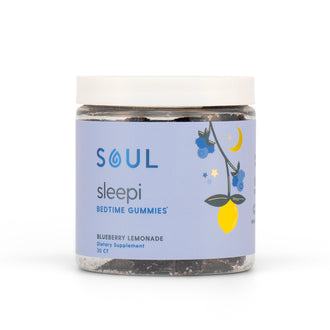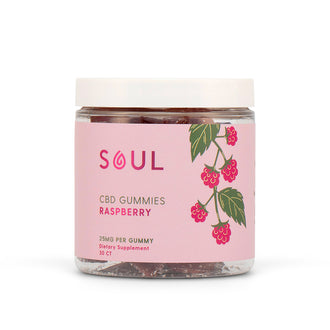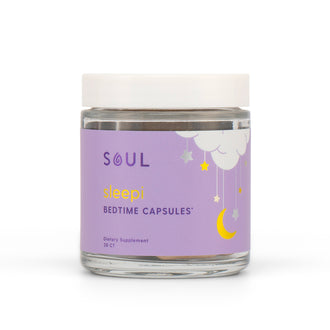
Key Takeaways:
- Consumption Dynamics: Understand the differences in onset time, duration, and effects between edibles and smoking.
- Health Considerations: Learn about the health impacts of each method, from lung health to digestion.
- Practical Guidance: Get tips on choosing the right method based on your lifestyle, needs, and preferences.
Choosing between edibles and smoking cannabis can feel like picking between two worlds—one offering a slow and steady journey, the other a quick burst of effects. It’s not just about preference; it’s about finding what fits your lifestyle, health, and needs.
At Soul, we take pride in being a trusted leader in the CBD space. Every product we create is crafted with care, combining the highest standards of quality, clean ingredients, and doctor-approved formulations to support your wellness journey.
In this article, we’ll guide you through the key differences, benefits, and challenges of edibles and smoking. By the end, you’ll have a clear understanding of which method is right for you.
Understanding Edibles And Their Effects
Edibles are a popular way to consume cannabis, offering a discreet and flavorful alternative to smoking or vaping. Their unique appeal lies in how they interact with the body, producing effects that are often more potent and long-lasting. This guide explores what edibles are and how they work, delving into their effects and what makes them a favored choice for many cannabis users.
What Are Edibles?
Edibles are food and beverage items infused with cannabis extracts, such as THC or CBD. These products come in diverse forms, including baked goods, candies, beverages, and even savory snacks. By infusing cannabis into consumable items, edibles offer an approachable and often delicious way for users to experience the effects of cannabis.
How Are Edibles Processed In The Body?
When consumed, edibles are digested and metabolized by the liver, unlike inhaled cannabis, which enters the bloodstream through the lungs. In the liver, THC is converted into 11-hydroxy-THC, a compound known for its increased potency and longer-lasting effects. This metabolic process distinguishes edibles from other methods of cannabis consumption.
Why Do Edibles Take Longer To Work?
The delayed onset of effects from edibles occurs because the body must first digest the product before THC enters the bloodstream. This process typically takes 30 minutes to 2 hours, depending on factors like the individual's metabolism, the edible's composition, and whether it is consumed on an empty or full stomach. While the delay can be frustrating for some, it contributes to the sustained and more intense high that many users prefer.
How Long Do Edible Effects Last?
The effects of edibles can last significantly longer than those from smoking or vaping, often enduring for several hours. This longevity makes edibles an appealing option for those seeking extended relief from conditions such as chronic pain or anxiety. However, it also means that dosing should be approached cautiously, as the effects cannot be quickly reversed.
Why Are Edibles A Popular Choice?
Edibles are favored for their convenience, discreet nature, and ability to deliver consistent doses. They are also preferred by those who wish to avoid the potential respiratory risks associated with smoking. For medicinal users, edibles provide an effective way to achieve sustained relief, while recreational users enjoy their versatility and potency.
Understanding How Smoking Cannabis Works
Smoking cannabis is one of the most common and traditional methods of consumption, prized for its rapid onset of effects and straightforward approach. It involves inhaling the smoke from burning cannabis flowers, delivering immediate psychoactive effects. This article explores the mechanics of smoking cannabis, its benefits, and its limitations.
How Smoking Delivers THC
When cannabis is smoked, THC and other cannabinoids are released into the smoke and inhaled into the lungs. The lungs act as a gateway, absorbing these compounds into the bloodstream almost instantly. This rapid absorption allows users to feel the effects of cannabis within minutes, offering a fast and efficient method of consumption.
Different Methods Of Smoking Cannabis
Cannabis can be smoked in various ways, including through joints, pipes, or bongs. Joints involve rolling cannabis in paper, while pipes and bongs provide a more structured tool for inhalation. Each method offers a slightly different experience in terms of flavor, convenience, and intensity, catering to diverse user preferences.
Why Smoking Provides Quick Relief
Smoking cannabis is often chosen for its near-instant effects, which make it ideal for individuals seeking immediate relief from conditions like pain, stress, or nausea. The quick onset is due to the direct absorption of THC into the bloodstream via the lungs. This immediacy makes smoking particularly appealing for users looking for quick results rather than waiting for delayed effects.
How Long The Effects Last
The effects of smoking cannabis are relatively short-lived, typically lasting between 1 to 3 hours. This duration allows for recreational use without the commitment of prolonged intoxication. However, the fleeting nature of the effects also means users may need to consume more frequently to maintain the desired experience.
The Appeal And Limitations Of Smoking Cannabis
Smoking is popular due to its simplicity, minimal preparation, and the ability to control dosage with each inhalation. However, the method does come with drawbacks, including potential respiratory irritation and the need to smoke in appropriate settings. Despite these limitations, the ease and immediacy of smoking continue to make it a go-to choice for many cannabis users.
The Pros Of Consuming Edibles
Edibles offer several advantages that make them a favorite for many cannabis enthusiasts:
- Discreet and Convenient: Edibles look just like regular snacks, making them easy to consume without drawing attention. There’s no need for special equipment, smoke, or lingering odors, which is ideal for people seeking a low-key option.
- Long-Lasting Effects: Since edibles are metabolized by the digestive system, their effects last much longer than smoking—often up to 6-8 hours or more. This makes them a great choice for sustained relief from pain, anxiety, or insomnia.
- No Smoke or Harshness: For those who are health-conscious or sensitive to smoke, edibles provide a smoke-free way to enjoy cannabis. This eliminates the potential respiratory irritation associated with smoking.
- Precise Dosage: Edibles are often labeled with exact THC and CBD amounts, giving users better control over their dosage compared to the unpredictability of smoking.
The Cons Of Consuming Edibles
While edibles have their perks, they also come with some drawbacks worth considering:
- Delayed Onset: The biggest challenge with edibles is the waiting game. Since they need to pass through the digestive system, the effects can take anywhere from 30 minutes to 2 hours to kick in. This delay often leads to impatient users consuming more than intended, resulting in an overly intense experience.
- Difficult to Predict Effects: Everyone’s metabolism is different, which makes the strength and duration of edibles somewhat unpredictable. Factors like what you’ve eaten, your tolerance, and body chemistry all play a role in how you feel.
- Potential for Overconsumption: Unlike smoking, where the effects are almost immediate and easier to gauge, edibles can trick users into thinking they haven’t taken enough. Overconsumption can lead to uncomfortable experiences like anxiety, paranoia, or nausea.
- Not Ideal for Quick Relief: If you’re looking for fast-acting effects, edibles are not the best choice. The delayed onset makes them less suitable for immediate relief from pain or stress.
Exploring The Benefits Of Smoking Cannabis
Smoking cannabis continues to be a favored method for both recreational and medicinal users, thanks to its unique advantages. It offers immediate effects, flexibility in consumption methods, and an inherently social aspect that resonates with many. Below, we delve into the key benefits that make smoking a popular choice.
Rapid Onset Of Effects
One of the most significant advantages of smoking cannabis is how quickly the effects take hold. THC enters the bloodstream almost immediately through the lungs, allowing users to feel the effects within minutes. This makes smoking an excellent option for those seeking prompt relief from acute pain, anxiety, or stress.
Precision In Dosage Control
Smoking cannabis allows for precise control over dosage, as the effects are felt in real time. Users can take small, measured inhalations and pause once the desired level of intoxication or relief is achieved. This control helps minimize the risk of overconsumption, which can sometimes occur with slower-acting methods like edibles.
A Range Of Consumption Methods
The versatility of smoking cannabis is another key benefit, offering multiple ways to consume the plant. Whether rolled into joints, smoked from pipes, or inhaled through water-filtered bongs, these methods provide users with varied experiences in terms of flavor, intensity, and convenience. This flexibility allows individuals to tailor their cannabis use to their preferences.
A Social Experience
Smoking cannabis often carries a communal aspect, making it an appealing choice for social settings. Sharing a joint, pipe, or bong creates a shared experience that fosters connection and camaraderie among users. This social dynamic adds to the enjoyment for many and sets smoking apart from other consumption methods like edibles or tinctures, which are often more solitary.
Understanding The Drawbacks Of Smoking Cannabis
While smoking cannabis offers fast and convenient effects, it’s not without its downsides. The method has certain limitations and health considerations that may make it less suitable for some users. This section explores the key disadvantages of smoking cannabis, offering a balanced perspective.
Health Concerns From Inhalation
Smoking cannabis involves inhaling combusted plant material, which can irritate the lungs and airways. Over time, frequent smoking may contribute to respiratory issues, even though cannabis smoke is generally considered less harmful than tobacco. This health risk makes smoking a less appealing option for those with pre-existing lung conditions or concerns about respiratory health.
Shorter Duration Of Effects
One drawback of smoking cannabis is the relatively short-lived effects, which typically last 1 to 3 hours. While the rapid onset is advantageous for quick relief, the brevity of the high means users may need to consume more frequently to maintain their desired level of relief or intoxication. This can be inconvenient for those seeking sustained effects.
Lingering Odor
Cannabis smoke has a distinct and strong smell that can cling to clothing, hair, and indoor spaces. This lingering odor makes smoking less discreet, potentially creating issues in environments where cannabis use is frowned upon. For some users, this lack of discretion can be a significant drawback.
Unsuitability For Non-Smokers
For individuals who do not smoke or find the act of smoking unpleasant, this method of consuming cannabis may not be suitable. The harshness of smoke can deter beginners or those with sensitive respiratory systems. Additionally, the process of smoking can feel intimidating to those unfamiliar with cannabis consumption techniques.
Comparing Edibles And Smoking Cannabis
When choosing between edibles and smoking, understanding their key differences can help you determine which method best suits your lifestyle, health concerns, and desired effects. Below are the main distinctions between these two popular consumption methods.
- Onset Time: Edibles take longer to kick in (30 minutes to 2 hours), while smoking delivers effects almost immediately within minutes.
- Duration of Effects: Edibles provide a longer-lasting high, typically lasting 6 to 8 hours or more, compared to smoking, which lasts around 1 to 3 hours.
- Potency and Experience: Edibles often produce a more intense, full-body high due to how THC is metabolized, while smoking offers a quicker, potentially less intense high.
- Health Considerations: Edibles are smoke-free, making them ideal for those concerned about respiratory health, whereas smoking may irritate the lungs due to inhalation of combusted material.
- Control and Convenience: Edibles allow for precise dosing but can be harder to adjust once consumed; smoking offers real-time control by adjusting the amount inhaled.
- Social and Lifestyle Factors: Edibles are discreet and suitable for solitary or casual use, while smoking is often a more social and ritualistic experience.
Understanding these distinctions can guide you toward the method that aligns with your preferences and goals.
Choosing The Right Option: Edibles Vs. Smoking
Deciding between edibles and smoking cannabis depends on your goals, lifestyle, health considerations, and level of experience. Both methods have unique benefits and challenges, and the best choice varies from person to person. Here’s a detailed look at the factors to consider when making your decision.
Aligning With Your Goals
Your intended outcomes play a significant role in choosing the best method of consumption. If you’re seeking immediate relief or a quick high, smoking may be the better choice due to its rapid onset. On the other hand, if your focus is on achieving long-lasting effects, such as sustained pain or stress relief, edibles offer the advantage of a prolonged experience that lasts several hours.
Considering Your Lifestyle
Lifestyle factors, including discretion and convenience, can heavily influence your decision. Edibles are an excellent option for those who prioritize subtlety, as they lack the strong odors associated with smoking and require no additional tools like pipes or bongs. However, if you value the communal and ritualistic aspects of cannabis use, smoking provides a social element that many enjoy, especially in group settings.
Weighing Health Concerns
Health considerations are another critical factor, particularly for those with respiratory sensitivities. Edibles are smoke-free, making them a gentler option for the lungs and overall respiratory system. Conversely, smoking is a more traditional method that appeals to those comfortable with inhalation and its associated risks, such as potential lung irritation.
Assessing Your Tolerance And Experience
Your level of experience with cannabis can also guide your choice. Beginners might find smoking more approachable, as it offers immediate feedback, allowing for precise adjustments to dosage. Edibles, while convenient, can be intimidating for those unfamiliar with their delayed onset and the possibility of overconsumption, which can result in an overwhelming experience.
Embracing Experimentation
Ultimately, there’s no one-size-fits-all answer to the question of which method is best. Many users find value in experimenting with both smoking and edibles, adapting their approach based on the situation or desired effects. By trying different methods, you can discover what aligns best with your personal preferences and needs.
Final Thoughts
Both edibles and smoking offer distinct advantages, catering to different needs and lifestyles. Edibles are ideal for those seeking a discreet, smoke-free option with long-lasting effects, making them perfect for sustained relief or low-profile consumption. Smoking, on the other hand, provides a quick onset, ease of dosage control, and a more traditional or social experience, appealing to users who prioritize immediacy or enjoy communal use.
Ultimately, the best method depends on your goals, health considerations, and tolerance. Whether you prefer the rapid effects of smoking or the prolonged experience of edibles, exploring both can help you discover what suits your preferences. With the knowledge of each method's benefits and limitations, you’re now ready to make an informed choice and enhance your cannabis journey.
Read also:
- How to Make Edibles Work Faster: Tips for a Quicker High
- Full-Spectrum Edibles: Everything You Need to Know
- Can CBD Gummies Help You Quit Smoking?
Frequently Asked Questions About Edibles vs Smoking
Can edibles and smoking be combined for a different effect?
Yes, combining edibles and smoking can create a layered experience, with the quick onset of smoking complementing the longer-lasting effects of edibles. However, start with low doses to avoid overconsumption.
Are edibles or smoking better for managing chronic pain?
Edibles are often better for chronic pain due to their sustained effects, while smoking can offer quick relief for acute flare-ups.
How do tolerance levels differ between edibles and smoking?
Tolerance builds differently. Regular smokers may find edibles stronger initially since edibles metabolize differently, but frequent edible use can also build a unique tolerance.
Can edibles or smoking affect your mental clarity differently?
Edibles can cause a stronger, more immersive high, which may temporarily impact mental clarity more than smoking, which tends to feel lighter and more controllable.
Are there legal differences between edibles and smoking in some regions?
Yes, in some places, laws may restrict edible products more strictly due to their potency and appeal to younger users. Always check local regulations.
Do edibles and smoking have different environmental impacts?
Smoking produces smoke and ash waste, while edibles involve packaging waste, often making eco-conscious users prefer brands using sustainable materials.
How do edibles affect hydration compared to smoking?
Edibles can dehydrate the body less than smoking, as inhaling smoke can dry out the mouth and throat more significantly.
Which method is more beginner-friendly: edibles or smoking?
Smoking is generally easier for beginners due to the immediate effects, allowing for better dose control. Edibles require careful measurement and patience.
Can edibles or smoking affect appetite differently?
Both can cause the “munchies,” but edibles might trigger it more due to their stronger, body-focused high.
Do edibles and smoking differ in terms of cost efficiency?
While edibles may seem more expensive upfront, their long-lasting effects can make them more cost-efficient over time compared to smoking.
Sources:
- Barrus, D., Capogrossi, K., Cates, S., Gourdet, C., Peiper, N., Novak, S., Lefever, T., & Wiley, J. (2016). Tasty THC: Promises and Challenges of Cannabis Edibles. Methods Rep RTI Press. https://doi.org/10.3768/rtipress.2016.op.0035.1611
- Barrus, D., Capogrossi, K., Cates, S., Gourdet, C., Peiper, N., Novak, S., Lefever, T., & Wiley, J. (2016). Tasty THC: Promises and Challenges of Cannabis Edibles. Methods Rep RTI Press. https://doi.org/10.3768/rtipress.2016.op.0035.1611
- Steigerwald, S., Wong, P. O., Cohen, B. E., Ishida, J. H., Vali, M., Madden, E., & Keyhani, S. (2018). Smoking, Vaping, and Use of Edibles and Other Forms of Marijuana Among U.S. Adults. Annals of Internal Medicine, 169(12), 890. https://doi.org/10.7326/m18-1681






